Backpacking in Vermont it’s a breathtaking experience and fun for all types of backpackers, for backpackers seeking natural beauty and adventure, Vermont’s Green Mountains are an ideal destination.
With an abundance of trails to explore, the Green Mountain state offers a variety of experiences for outdoor enthusiasts.
Contents
Whether it’s a casual day hike or a multi-day backcountry trek, Vermont’s trails showcase the state’s diverse terrain and breathtaking vistas.
The Green Mountain National Forest is a backpacker’s paradise, with over 900 miles of hiking trails.
The area is home to the world-renowned Long Trail, which traverses the state from Massachusetts to the Canadian border.
Along the way, hikers can explore lush forests, mountain peaks, cascading waterfalls, and serene lakes.
From the stunning views on the Appalachian Trail to the picturesque Lye Brook Falls Trail, Vermont’s hiking routes offer a unique experience for every backpacker.
With so much to discover, it’s no wonder Vermont is a beloved destination for outdoor enthusiasts.
Key Takeaways:
- Vermont’s Green Mountains offer an abundance of trails for backpackers to explore.
- The Green Mountain National Forest has over 900 miles of hiking trails.
- The Long Trail traverses the state from Massachusetts to the Canadian border.
- Vermont’s hiking routes offer a unique experience for every backpacker.
- The state’s diverse terrain and breathtaking vistas make it a beloved destination for outdoor enthusiasts.
Exploring Vermont’s Green Mountains: A Backpacker’s Paradise
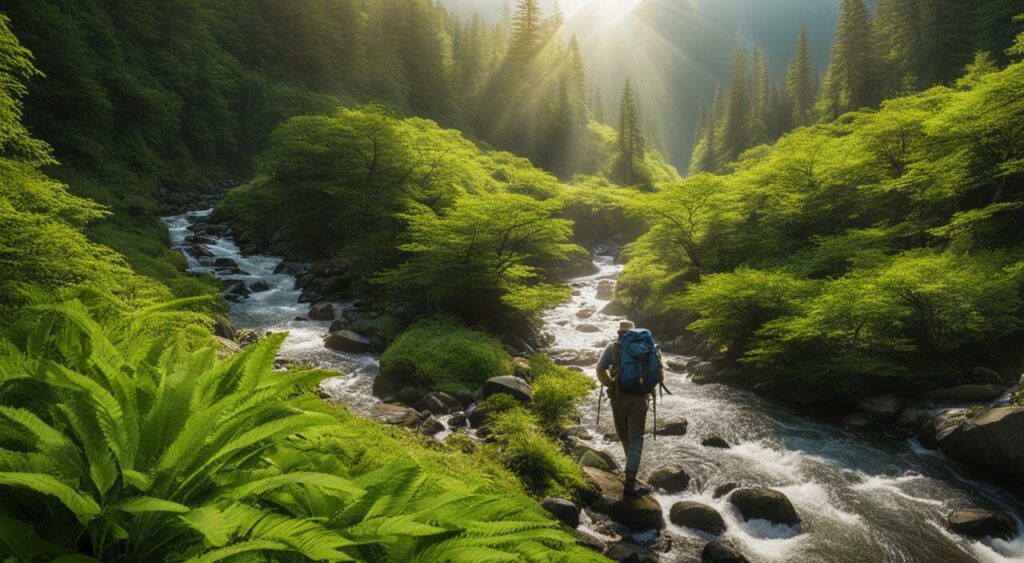
Vermont’s Green Mountains provide a stunning backdrop for backpackers seeking an adventure. With over 700 miles of trails, backpackers can explore the natural beauty of the state through diverse environments.
From forests to waterfalls, the Green Mountains offer breathtaking landscapes that beckon the adventurous.
The Green Mountain Club (GMC) is a non-profit organization that maintains Vermont’s hiking trails, including the Long Trail and the Appalachian Trail.
The GMC is also responsible for creating and maintaining the shelter system throughout the state.
With over 70 shelters located on various trails, backpackers can plan overnight trips with ease while exploring the unspoiled wilderness.
Backpacking trails in Vermont range from easy to strenuous, catering to different levels of experience.
Some of the most popular backpacking trails in the Green Mountains include the Monroe Skyline, the Mount Mansfield Loop, and the Lye Brook Falls Trail.
Monroe Skyline
The Monroe Skyline trail is a challenging 14.9-mile hike that offers spectacular views of the Green Mountains.
The trail is known for its rocky terrain, steep ascents, and descents, making it a popular choice for experienced backpackers.
The journey begins at the Appalachian Trailhead at Clarendon Gorge and leads to the summit of Mount Abraham.
Mount Mansfield Loop
At 11.2 miles, the Mount Mansfield Loop trail is relatively moderate, with a mix of easy and challenging sections.
The trail includes a hike to the summit of Mount Mansfield, Vermont’s tallest peak. Backpackers can enjoy stunning views of the surrounding valleys and peaks from the summit.
Lye Brook Falls Trail
The Lye Brook Falls Trail is a 4.5-mile round-trip hike that offers scenic views of Lye Brook Falls. It is a perfect trail for families or beginner backpackers.
The trailhead is located near the Vermont Country Store, making it a great stop for food and supplies before embarking on the hike.
Backpacking in Vermont is an unforgettable experience, with the Green Mountains providing a stunning backdrop for adventure.
With well-maintained trails, a shelter system, and diverse landscapes to explore, the state offers something for backpackers of all levels of experience.
With planning and the right gear, backpackers can immerse themselves in Vermont’s natural beauty and make memories that will last a lifetime.
Discovering the Lye Brook Falls Trail: A Scenic Adventure
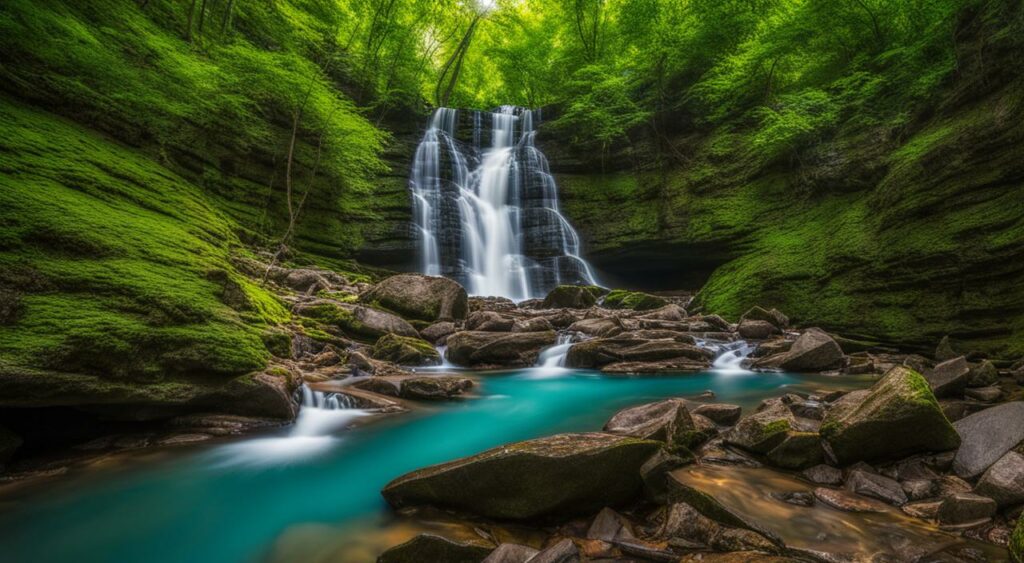
The Lye Brook Falls Trail is a must-visit for those who love hiking and scenic adventures. Situated in the heart of the Lye Brook Wilderness, the trail is a favorite among locals and tourists alike.
The nearly 4-mile-long trail takes you through lush green forests and picturesque streams, leading to the stunning Lye Brook Falls.
The falls cascade down a series of ledges, creating a breathtaking view that’s perfect for nature lovers and photographers. While the trail is moderately difficult, it’s well worth the effort.
The hike itself takes around 2-3 hours to complete, and the breathtaking views make it worthwhile. Visitors can take their time exploring the trail and the surrounding wilderness.
Trail Features
| Trail Feature | Description |
|---|---|
| Length | 3.7 miles round trip |
| Elevation Gain | 1,050 feet |
| Difficulty | Moderate |
| Waterfall | Lye Brook Falls |
The trail is well marked, with signage to guide you along the way. It’s recommended to wear sturdy hiking boots and bring plenty of water and snacks.
It’s also important to adhere to Leave No Trace principles and pack out all garbage. For those who want to make the most out of their trip, the nearby Vermont Country Store is a must-visit.
The store offers a wide selection of local products, including maple syrup, cheese, and homemade fudge.
“The Lye Brook Falls Trail is one of the most scenic hikes in Vermont, offering stunning views of the Green Mountains and beautiful waterfalls.” – John, avid hiker
Overall, the Lye Brook Falls Trail is a fantastic hike for those looking to experience Vermont’s natural beauty. The trail’s picturesque views and nearby attractions make it a destination that you won’t want to miss.
Hiking the Appalachian Trail in Vermont: A Bucket List Journey
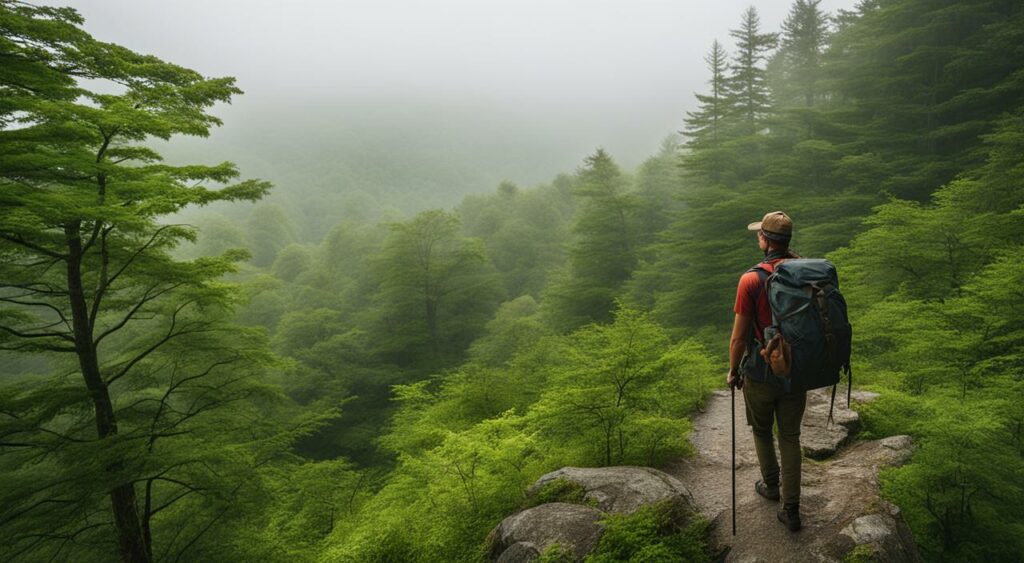
The Appalachian Trail is perhaps one of the most iconic and challenging long-distance hiking trails in the United States, spanning over 2,200 miles through the Appalachian Mountains.
And while the trail passes through 14 states, the portion that runs through Vermont is particularly special, offering breathtaking views of the Green Mountain National Forest and the opportunity to witness Vermont’s natural beauty firsthand.
Vermont’s Appalachian Trail stretches over 100 miles, starting at the Massachusetts border and ending at the town of Norwich, passing through the towns and mountains of southern Vermont along the way.
Backpackers can expect to encounter rocky terrain, steep inclines, and challenging weather conditions, making it an unforgettable adventure for those who are up for the challenge.
Hiking the Appalachian Trail in Vermont offers an unparalleled opportunity to explore the natural beauty of the Green Mountain State.
The trail passes through some of Vermont’s most pristine wilderness areas, offering hikers the chance to witness stunning vistas, towering forests, and crystal-clear streams.
| Best time to hike | Difficulty | Distance | Starting point |
|---|---|---|---|
| Late spring to early fall | Strenuous | 105.8 miles | Southern Vermont border with Massachusetts |
The best time to hike the Appalachian Trail in Vermont is from late spring to early fall, when the weather is moderate and the foliage is at its peak.
Backpackers should be prepared for strenuous hiking, with steep inclines and rocky terrain making for a challenging journey.
The trail is well-marked and maintained by the Green Mountain Club, a non-profit organization that maintains the Long Trail and Appalachian Trail in Vermont.
The organization offers a variety of resources for backpackers, including maps, guidebooks, and trail updates.
Hiking the Appalachian Trail in Vermont is not just a physical challenge, but a spiritual one as well.
The trail is a journey through some of Vermont’s most awe-inspiring landscapes, offering backpackers a chance to connect with nature and themselves.
For those who are up for the challenge, hiking the Appalachian Trail in Vermont is an experience of a lifetime.
It offers an unforgettable journey through some of the most beautiful landscapes in New England, with the potential to test one’s physical and mental limits and leave a lasting impression.
Overnight Hikes: Immersing in Vermont’s Wilderness
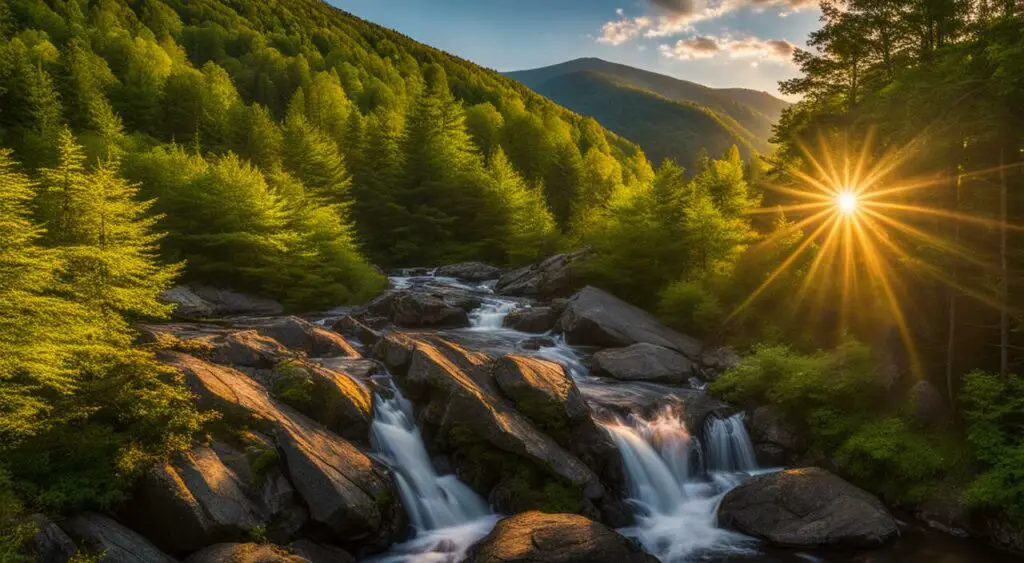
For those looking to truly immerse themselves in the wilderness of Vermont, overnight hikes are a must-do experience.
The mountains and greenery of Vermont make it a perfect destination for those seeking an unforgettable backpacking adventure.
One popular overnight hike in Vermont is the Long Trail, which spans 273 miles from the Massachusetts-Vermont state line to the Canadian border.
The trail passes through various peaks and valleys, providing stunning views of the Green Mountains along the way.
Another popular overnight hike is the Breadloaf Wilderness Loop, which takes hikers through the Green Mountain National Forest.
The loop includes various trails that pass through scenic areas such as Mount Wilson and Little Rock Pond, providing an all-encompassing taste of Vermont’s natural beauty.
With an abundance of hiking trails and mountains, Vermont offers backpackers an unparalleled opportunity to explore and experience the state’s vast wilderness.
However, it is important to note that overnight hiking requires adequate preparation and planning.
Backpackers need to ensure they have the necessary gear and supplies, including a tent, sleeping bag, and cooking equipment.
Additionally, it is important to research and plan the best routes and campsites ahead of time.
Overall, overnight hikes offer backpackers a chance to truly connect with nature and immerse themselves in Vermont’s wild side.
With its stunning mountain ranges and abundance of hiking trails, Vermont is a backpacker’s paradise.
Mount Mansfield: Conquering Vermont’s Tallest Peak

As the tallest peak in Vermont, Mount Mansfield is a must-visit destination for backpackers seeking an exhilarating challenge.
Located in the heart of the Green Mountain National Forest, the mountain boasts some of the state’s most breathtaking views and a network of hiking trails to explore.
Hiking enthusiasts can choose from a variety of trails, each with its own unique features and challenges.
The Hell Brook Trail, for example, is known for its steep inclines and rugged terrain, while the Long Trail offers a more leisurely, scenic route to the summit.
| Trail Name | Difficulty | Distance |
|---|---|---|
| Hell Brook Trail | Difficult | 3.5 miles |
| Long Trail | Moderate | 4.4 miles |
| Sunset Ridge Trail | Moderate | 4.5 miles |
Backpackers should be prepared for changing weather conditions, as temperatures can vary greatly at higher elevations.
It is also important to keep an eye out for wildlife, including bears and moose, and to follow proper safety precautions in bear country.
For those seeking an extra adventure, the mountain offers opportunities for backcountry camping, allowing backpackers to truly immerse themselves in Vermont’s wilderness.
The Green Mountain Club provides information on the best campsites and backcountry travel regulations.
Conquering Mount Mansfield is an unforgettable experience for any backpacker.
With its challenging trails and stunning views, it is no wonder why the mountain is a popular destination for hikers and adventurers alike.
So pack your bags and get ready for the adventure of a lifetime!
Shelter System: Planning Overnight Backpacking Trips
When planning an overnight backpacking trip in Vermont, it’s important to be aware of the shelter system in place.
The Green Mountain Club manages dozens of shelters throughout the state, providing convenient and safe places to rest overnight.
Backpackers can find these shelters along many of the hiking trails in Vermont, including the famous Long Trail and the Appalachian Trail.
The shelters are typically simple structures, with wooden bunks and a roof overhead. To use the shelter system, backpackers must be members of the Green Mountain Club.
Membership passes can be purchased on their website or at any of the shelters. This ensures that the shelters are well-maintained and available for use by those who respect the natural environment.
It’s worth noting that the shelters are available on a first-come, first-served basis.
If all the bunks are full, backpackers will need to find alternate accommodations for the night. It’s always a good idea to have a backup plan in case the shelters are full.
Mountain Club Membership
Becoming a member of the Green Mountain Club provides several benefits beyond access to the shelter system.
Members receive discounts on merchandise at the club’s visitor centers, as well as discounts on guided hikes and outings.
Membership also supports the club’s mission of preserving and protecting the trails and natural lands of Vermont for future generations.
Overnight Trips
Planning an overnight backpacking trip in Vermont requires careful consideration of gear, route, and safety.
The Green Mountain Club has several resources available to help backpackers plan their trips, including maps, guidebooks, and trail recommendations.
It’s important to research the route in advance and be aware of any potential hazards or steep inclines.
Having appropriate gear, including a reliable backpack, tent, sleeping bag, and food and water provisions, is also essential.
Backpackers should always follow Leave No Trace principles and take care not to damage the natural environment.
This includes packing out all trash and being mindful of campfires and other potential sources of damage.
By utilizing the shelter system and following proper planning and safety procedures, backpackers can enjoy a safe and rewarding overnight trek through Vermont’s wilderness.
Essential Backpacking Gear for Vermont Trips
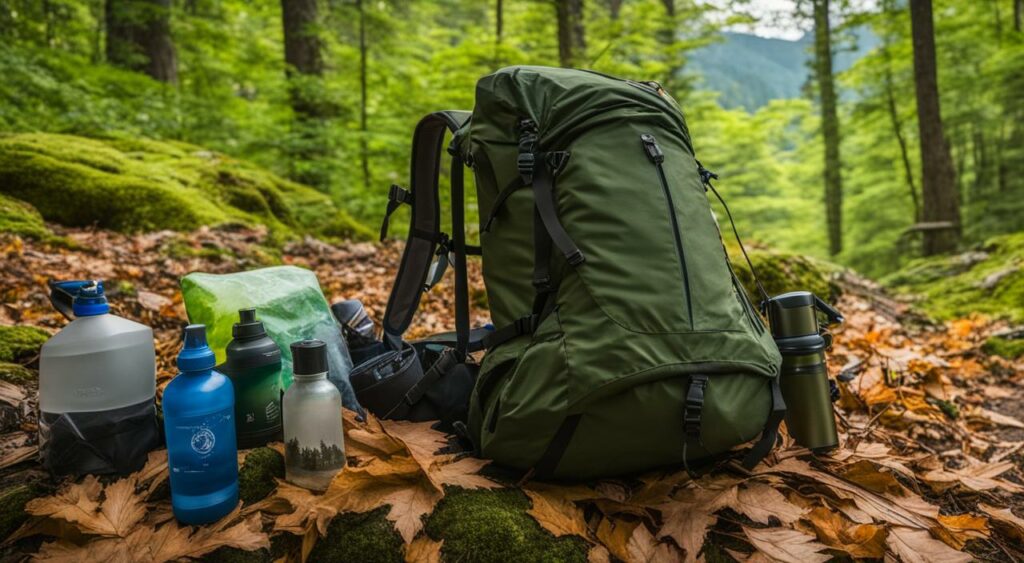
Backpacking in Vermont offers adventure, scenic beauty, and a chance to escape into nature.
To ensure a successful trip, it’s essential to have the right gear. The following items are key to a safe and comfortable backpacking journey through Vermont.
Backpack
A durable and comfortable backpack is essential for carrying all necessary gear. Look for a backpack with adjustable straps, multiple compartments, and a waterproof cover. A 40-60 liter backpack is usually sufficient for a multi-day backpacking trip.
Tent and Sleeping Bag
A reliable and lightweight tent is crucial for shelter in the wilderness. Choose a tent that is easy to set up and has a waterproof rainfly.
A lightweight sleeping bag with a temperature rating suitable for the season is also important for a good night’s sleep.
Cooking Equipment
Sturdy cookware and utensils are necessary for preparing meals on the trail. A lightweight camping stove, fuel, and a pot for boiling water are essential. A spork, knife, and cutting board are also helpful.
Water Filtration System
Access to clean drinking water is essential in the backcountry. A water filtration system, such as a filter or purification tablets, is necessary for filtering water from streams and lakes.
Navigation and Lighting
A map and compass are crucial for navigation in the wilderness. A headlamp or flashlight is also necessary for lighting the way in the dark.
Clothing and Footwear
Dress appropriately for the weather and terrain. Lightweight, moisture-wicking clothing is best for warm weather, while warm layers and waterproof gear are essential for cold weather.
Sturdy, waterproof hiking boots are also necessary for traversing the varied terrain of Vermont’s backpacking trails.
Best Campsites
Vermont offers a variety of campsites and shelters to choose from. The Green Mountain Club maintains numerous shelters and campsites along the Long Trail, offering a safe and comfortable place to rest for backpackers.
Some popular campsites include:
| Campsite | Location |
|---|---|
| Bamforth Ridge Shelter | North Adams, MA |
| Corliss Camp | Shelburne, VT |
| Taft Lodge | Stowe, VT |
It’s important to plan ahead and reserve campsites where necessary, especially during peak hiking season.
Backpacking Tips
Finally, here are some additional tips for a successful backpacking trip in Vermont:
- Research trail conditions and weather before departing
- Pack out all trash and leave no trace
- Respect wildlife and their habitats
- Carry emergency supplies, including a first aid kit and a whistle
- Inform someone of your trip itinerary and expected return date
Exploring Nature in Vermont: Beyond Backpacking
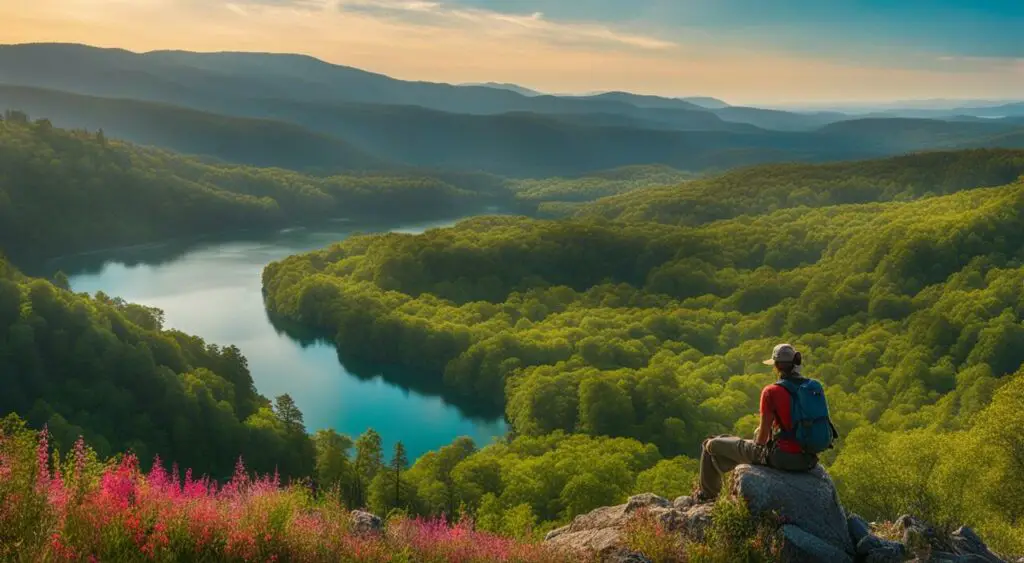
While backpacking is a fantastic way to experience Vermont’s natural beauty, there are other ways to explore the state’s wilderness.
Backcountry travel, for instance, allows travelers to venture off the beaten path and discover the hidden gems of Vermont’s landscape.
There are also countless backpacking routes that take hikers through diverse ecosystems, showcasing everything from lush green forests to open meadows and rocky peaks.
For those interested in backcountry travel, there are many options available.
Vermont has an extensive trail system, including the Long Trail, which runs north-south through the state and offers a more rugged, challenging experience than some of the other trails.
The Catamount Trail, on the other hand, is a cross-country ski trail that also offers opportunities for backcountry travel in the warmer months.
Exploring the Northern Forest Canoe Trail
Another unique way to experience Vermont’s natural beauty is by paddling the Northern Forest Canoe Trail.
This 740-mile-long waterway runs from Old Forge, New York, to Fort Kent, Maine, and passes through Vermont’s Northeast Kingdom.
Along the way, paddlers can take in stunning views of the state’s forests, mountains, and wildlife. There are many opportunities for backpacking within the Northern Forest Canoe Trail corridor as well.
The trail passes through some of Vermont’s most scenic areas, including the Green Mountain National Forest and the Northeast Kingdom.
Backpackers can choose from a variety of trails, ranging from easy day hikes to multi-day backpacking trips.
Exploring Vermont’s Fall Foliage
Vermont is known for its stunning fall foliage, which draws visitors from all over the world. Backpackers can take advantage of this colorful season by exploring the state’s many hiking trails during the autumn months.
Some popular routes for fall foliage viewing include the Mount Mansfield Summit Ridge Trail and the Stowe Pinnacle Trail.
With its abundance of natural beauty, Vermont is the perfect destination for those looking to explore the great outdoors.
Whether backpacking, backcountry travel, or paddling the Northern Forest Canoe Trail, there are countless opportunities to immerse oneself in the state’s wilderness.
So plan your next adventure today and discover all that Vermont has to offer!

Conclusion
Backpacking in Vermont offers an unparalleled adventure to those seeking to connect with nature.
The Green Mountains provide a picturesque backdrop to the array of trails available for exploration.
The Green Mountain Club provides a wealth of information and support for backpackers embarking on their journey.
Visiting the Lye Brook Falls Trail and the Vermont Country Store, hiking the Appalachian Trail, and conquering Mount Mansfield are just a few of the experiences waiting to be had in Vermont.
Overnight hikes offer backpackers the opportunity to immerse themselves in Vermont’s stunning wilderness.
The shelter system and essential backpacking gear guide in this article will help backpackers plan their trips with ease.
However, Vermont has so much more to offer beyond backpacking.
Exploring nature through backcountry travel and various backpacking routes will provide visitors with a glimpse of Vermont’s diverse natural landscapes.
So, pack your bags, grab your gear, and embark on your own backpacking journey in Vermont. The adventure awaits!

FAQ
-
What is Backpacking in Vermont?
Backpacking in Vermont refers to the activity of exploring the state’s natural beauty and wilderness areas on foot, carrying essential supplies and equipment in a backpack.
-
Why is Vermont known as the Green Mountain State?
Vermont is known as the Green Mountain State due to its picturesque mountain range, the Green Mountains, which cover a significant portion of the state.
-
Are there any backpacking trails in Vermont?
Yes, Vermont offers a wide range of backpacking trails, including those maintained by the Green Mountain Club and the famous Appalachian Trail that runs through the state.
-
What is the Green Mountain Club?
The Green Mountain Club is a non-profit organization dedicated to the preservation and maintenance of hiking trails in Vermont, including the Long Trail and a network of other trails.
-
What is the Lye Brook Falls Trail?
The Lye Brook Falls Trail is a scenic hiking trail in Vermont known for its beautiful waterfall and picturesque views. The trail is located near the Vermont Country Store.
-
What is the Appalachian Trail in Vermont?
The Appalachian Trail in Vermont is a portion of the famous long-distance hiking trail that spans from Georgia to Maine. In Vermont, it passes through the Green Mountain National Forest and offers breathtaking views.
-
Can I go on overnight hikes in Vermont?
Yes, Vermont offers opportunities for backpackers to go on overnight hikes and camp in the wilderness. It allows for a more immersive experience in the state’s natural beauty.
-
What is Mount Mansfield?
Mount Mansfield is the highest peak in Vermont, offering stunning panoramic views of the surrounding Green Mountains. It has various hiking trails leading to its summit.
-
Are there shelters available for overnight backpacking trips?
Yes, Vermont has a shelter system maintained by the Green Mountain Club that provides backpackers with overnight accommodations along popular hiking trails.
-
What essential gear do I need for backpacking in Vermont?
Essential backpacking gear for Vermont trips includes a sturdy backpack, proper hiking boots, a map and compass, a tent or sleeping bag for overnight stays, and adequate food and water supplies.
-
Can I explore nature in Vermont without backpacking?
Absolutely! In addition to backpacking, Vermont offers numerous opportunities for exploring nature through backcountry travel, scenic drives, and various designated hiking routes.







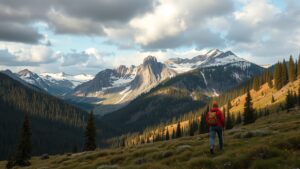

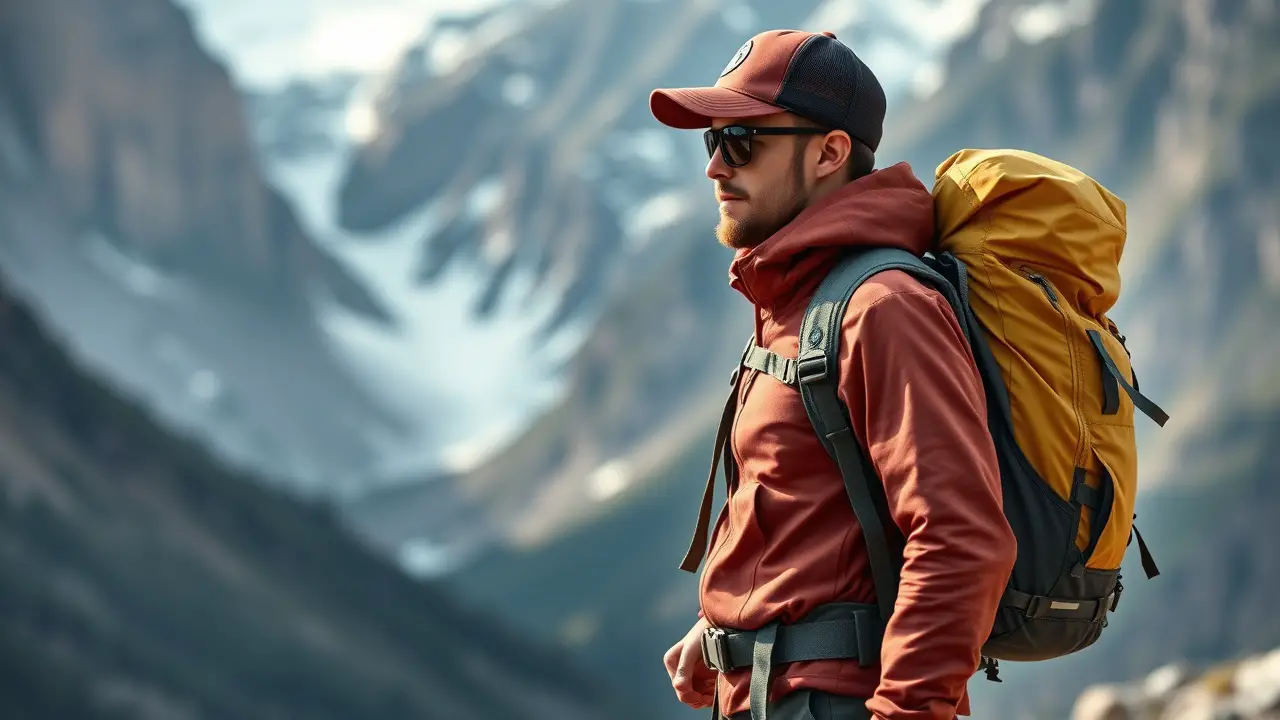
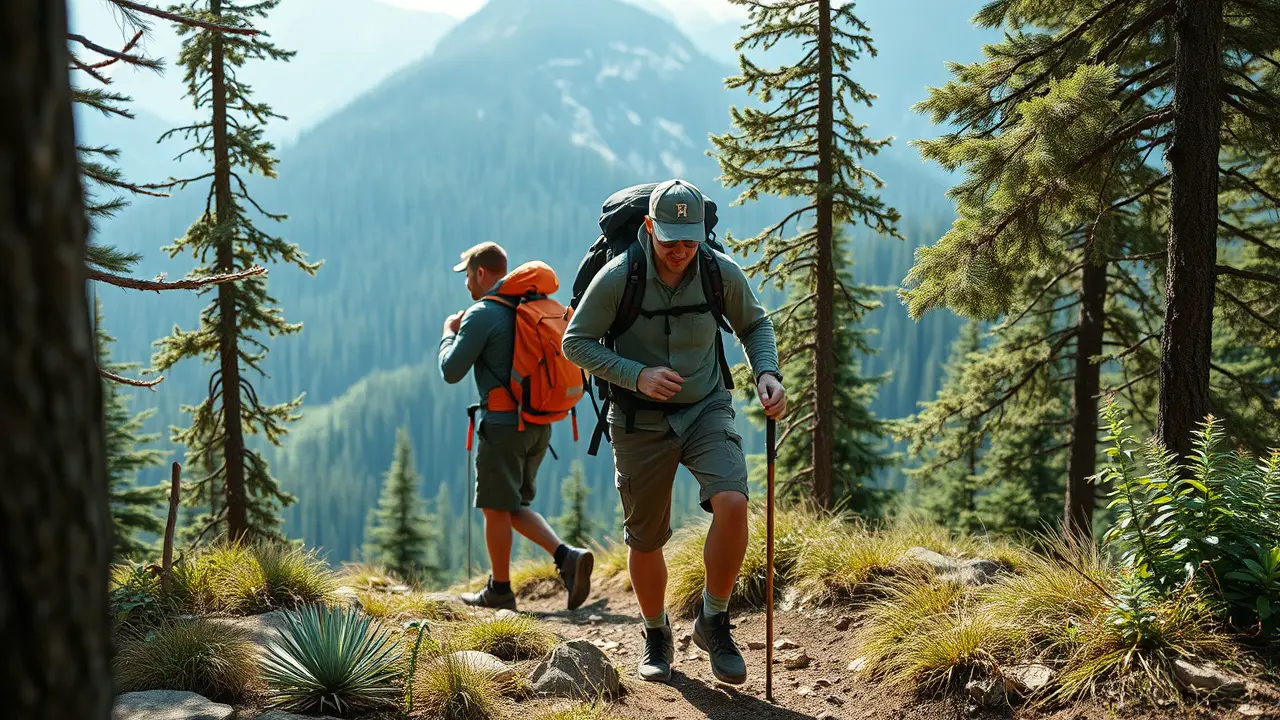
Leave a Reply